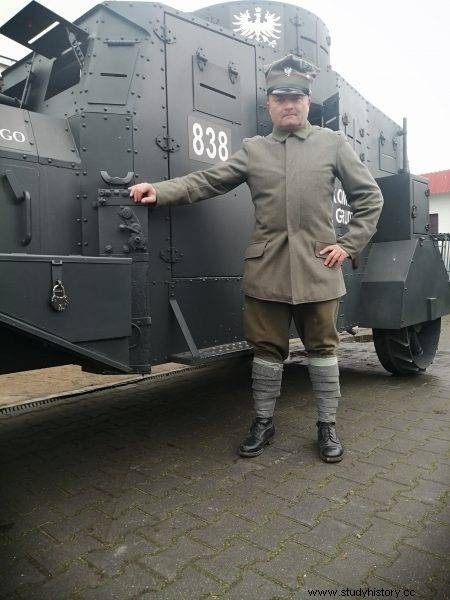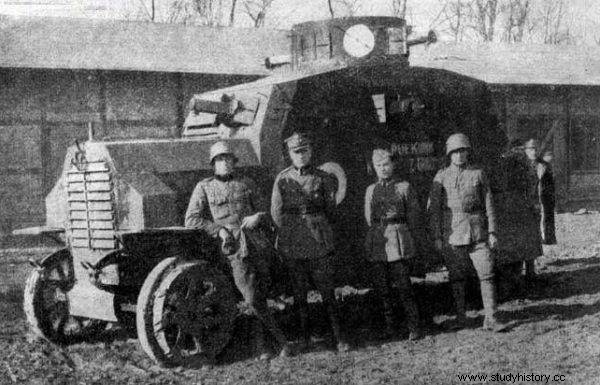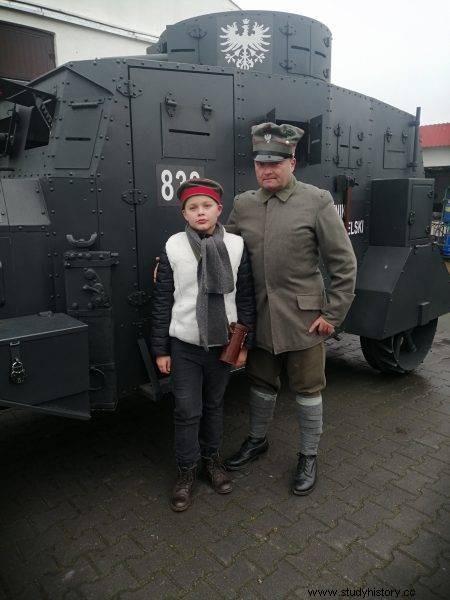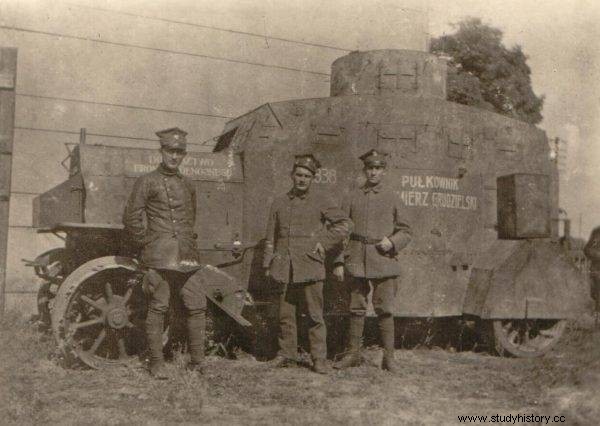He was one of the showpieces of the Greater Poland Uprising. He was, next to armored trains, the only armored force of Poles. Ehrhardt M17 - battleship from Wilhelm's regiment.
He was one of the showpieces of the Greater Poland Uprising, as well as the Third Silesian Uprising. He even became the protagonist of the song, sung in the imitation and melody of the Christmas carol "Among the Night's Silence". This is the armored car Ehrhardt M17 - battleship from the Wilhelm regiment. A nice copy of it, built in Budzyń, where the original changed its owner a hundred years ago, has graced insurgent reconstructions for three years.
Next Generation War
The fights of the Greater Poland Uprising were a projection of the technical and tactical gains of the just ended World War I. This was favored by the use of modern weapons, just introduced into the line . The last generation of planes took off, including high-altitude Rumplers, armor (cars and trains) and chemical weapons (war gases) were used on the ground.

A nice copy of it, built in Budzyń, where the original changed its owner a hundred years ago, has graced insurgent reconstructions for three years.
First of all, this equipment was at the disposal of the German side, which used it in combat without restrictions . Insurgents from Wielkopolska had only what they managed to get:planes at the air base in Ławica near Poznań and in the Zeppelin hall in Winiary, an armored train - taken over in the Battle of Rynarzew on February 6, 1919, or land "battleship", i.e. a car Panzer Erhardt M17 - captured in the skirmish near Budzyń.
Mobile machine gun stand
The latter vehicle was an effective weapon, providing a combination of appropriate machine gun fire projection and the ability to quickly reach the target. It represented the first production series of the M17, better than the weaker, later M19, and produced in a number of several dozen on the basis of the EV / 4 truck.
This car could move not only on the road, but also off-road, incl. thanks to permanent all-wheel drive. Provided support for infantry with fire from 3-5 machine guns, including one in the moving turret on the roof of the vehicle. If used against infantry in conditions where its crew imposes their initiative on the enemy, it would be a very difficult opponent. But on February 7, 1919 the crew of a car going to fight the Greater Poland insurgents lost this initiative in the first second of the fight ...
Circle Trap
The insurgents from Wielkopolska "hunted" Ehrhardt while he was patrolling the vicinity of Budzyń. Unfortunately for me, alone - without the support of other armored vehicles or infantry. In fact, Poles expected the German attack on Budzyń because sergeant Wiktor Skotarczak, at the head of the Rogozin company, commanding on January 5, 1919, the action of seizing Budzyń, Sokołów and Ryczywół received information that he could expect an attack on the city.

The Greater Poland insurgents "hunted" Ehrhardt while he was patrolling the vicinity of Budzyń.
Skotarczak was an experienced front man from the First World War and not for nothing the German command offered a reward of 50,000 marks for killing or delivering him alive . Now he ordered Leon Napiecek, known to him for his participation in the capture of Budzyń and Chodzież, to along with fifteen soldiers to line up behind Budzyń on the Okręglik hill , by the Chodzież road and there awaited the potential arrival of the Germans.
So Leon Napiecek went to Okręglik on February 7, 1919, he chose places above the road and started waiting. There were shooters on the left side of the road, and an MG08 machine gun was placed above it and at the same time on its axis, with Stanisław Kozłowski and Szczepan Wikariusz watching over it. It was to them that the decisive share in the victory in Budzyń was bequeathed to them.
Daring action
Around 3 p.m., the insurgents heard the sound of a car engine. Immediately afterwards they saw a gray box with a characteristic turret with a machine gun. Kozłowski and the Vicar already had an ammunition belt on, held by the Vicar, and Kozłowski pulled back the lock of their weapons. MG08 machine guns were used to cover a fragment of the area with dense fire in front of the barrel, and not for single sniper shots, Stanisław Kozłowski thought that his task would be to stop the infantry accompanying the fighting vehicle .

Erhardt's reconstruction in Budzyń
However, an oncoming armored car with a black cross on its radiator louvers drove without cover, alone. Moreover, his driver, not knowing the threat, had an open armor plate covering his position to see the way better. This is where the Polish heavy machine guns were aiming . When Erhardt reached the distance of about fifty meters, Kozłowski opened fire, immediately hitting the car. The bullets that fell inside fatally hit the driver and two German soldiers which caused the vehicle to veer off the road and stop in a roadside ditch.
The car crew tried to alert the German unit stationed in the neighboring Podanin and thus call for relief, but the fired yellow signal rocket did not fly high - it made a small arc and fell. The Podanin unit did not find out that the "battleship" was in trouble ...
Precious booty
The commander of the armored car crew was lieutenant Kurt Amos, and there was also a second officer on board, lieutenant Joachim graf von Schwerin-Janow. Both found the attackers outnumbered . The explosion of a grenade thrown by the approaching Leon Napiecek let them know that there is no more time to effectively defend the immobilized car. So Lieutenant von Schwerin-Janow pulled out his pistol and jumped outside. Behind him the rest of the crew. As it turned out - straight into the concentric, accurate fire of the Poles.
Both officers and one soldier were killed - a total of six crew members lost their lives . The second driver of the car was to be captured. It is possible that there was another soldier who managed to escape. However, he was to die as a result of his injuries. The insurgents suffered no losses. They did get an armored car , armed with four machine guns. In addition, a lot of ammunition, two signal pistols and - as the then chronicler wrote - seven hundred hand grenades, which, however, seems to be a gross exaggeration. To accommodate the entire load and crew, Ehrhardt would have to have the capacity of a railway wagon. Nevertheless, the loot was impressive.

The captured car was transported to Poznań, where it was given the name "Colonel Kazimierz Grudzielski"
The insurgents brought six horses to the place of the skirmish, with the help of which the vehicle was pulled out of the ditch. After it was launched, it drove into Budzyń, led under the white and red flag by proud insurgents. The fallen Germans were buried with military honors at the local Evangelical cemetery.
"Grudzielski" as "Upper Silesia"
The captured car was transported to Poznań, where it was given the name "Colonel Kazimierz Grudzielski" in honor of the soldiers' favorite, somewhat impulsive commander of the Northern Front. The car later took part in the fights near Zamość in March 1919, and during the Third Silesian Uprising - near Kędzierzyn and Żyrowa. During this uprising it was repainted and was called "Upper Silesia - Alsace". Initially, he was stationed in Poznań, in the second armored car squadron, later, in November 1925, he was sent to Warsaw and never returned to Greater Poland. In 1928 the car was removed from service and scrapped.
Bibliography:
- Members of the group Erhardt M-17 starred in the movie about colonel Grudzielski , chodzież.naszemiasto.pl, 6 March 2021.
- Magnuski Janusz, Armored cars of the Polish Army 1918-1939, Warsaw 1993.
- Okoński Grzegorz, Panzer Colonel Grudzielski - insurgent capture from Gostyń , Głos Wielkopolski, January 8, 2022.
